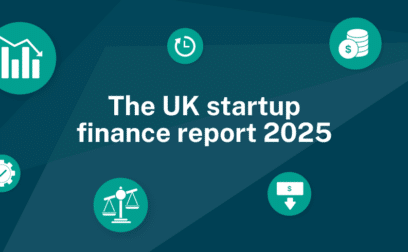TABLE OF CONTENTS
Page written by Chris Godfrey. Last reviewed on October 2, 2024. Next review due April 6, 2027.

If you own or run a business you’ve probably heard the term ‘commercial financing’ before. But what does it mean, how does it work and is it right for your business? Well, wonder no more. Read on to find out all you need to know about commercial financing – and how you can make the most of it.
Commercial financing comes in many shapes and sizes, ranging from term loans and revolving lines of credit to business mortgages, equipment loans, cash advances and more:
The most common type of commercial loan and typically used for one-off investments where you know exactly how much cash you need. Bulk materials or inventory purchases, plant and equipment investment, and debt repayment and restructuring activities work well with this kind of term loan. You receive a single, lump-sum cash injection and then pay it back in regular instalments over a fixed period of up to 25 years. Collateral may be required.
This business loan functions like a high-value credit card but comes with lower interest rates and fees. Organisations can withdraw as much as they want when they want from a loan facility up to the limit of their borrowing. With a line of credit, interest rates are usually fixed, and businesses may repay on a set or flexible schedule. Collateral may be required.
Commercial real estate loans (also known as commercial mortgages) are used to buy properties that have a business function. This would include income-producing properties such as factories, offices, stores, restaurants, gas stations, gyms, theatres, sporting venues, etc. Although commercial real estate loans are similar to the residential mortgages used to buy homes, they differ in some key areas:
| Commercial | Residential | |
|---|---|---|
| Primary borrower | Business entity | Private individual |
| Type of property | Commercial property | Private residence |
| Loan repayment period | 10 to 25 years | 15, 20 or 30 years |
| Maximum loan to value (LTV) | 65% to 85% LTV | 95% LTV |
| Interest rates | Higher than residential | Lower than commercial |
| Fees | Higher than residential | Lower than commercial |
| Pre-payment penalties | Common | Rare |
Commercial construction loans are short-term funding instruments used to pay for building new income-producing properties or for the expansion, refurbishment or conversion of existing commercial properties. This type of loan typically pays out in instalments as each phase of the work is completed rather than all at once like a commercial mortgage. The loan is paid back when construction is complete, often by converting the debt to a less expensive commercial real estate loan.
Also known as account receivables financing, this type of loan allows you to borrow against the value of your unpaid invoices and is best for B2B organisations. The lender will usually provide up to 95% of the invoice value within a few days or even hours of the bill being raised. Your invoices act as security for the loan, no added collateral required.
Buying big ticket machinery and equipment can put a major dent in your cashflow, but equipment loans can pay for your new plant and machinery without causing financial stress. Equipment loans are ‘self-collateralising’ – they use the asset you’re financing as security, similar to a car loan or a residential mortgage – so no added collateral is required. You use the equipment as you pay for it and the lender maintains a lien on the machinery. Once you pay the loan back, the lender releases the lien, and you own the equipment outright.
Available for businesses that accept customer payments by credit and debit card. You borrow against the value of your card sales. As your card sales increase, your borrowing limit goes up. Pay the merchant cash advance back with a fixed percentage of your card sales on a daily, weekly or monthly basis. Your sales act as security for the loan, no added collateral is required.
Functions like a merchant cash advance but with higher borrowing limits. Based on the size and regularity of their total revenues, (not just their credit card sales), businesses may receive a lump sum and pay it back over a short-term schedule, typically by small deductions from their daily sales. This type of loan can usually be secured quickly as qualification rules are less intensive and credit scores are not so critical. No added collateral is required.
Inventory financing can come as a short-term loan, or a revolving line of credit and it is used to buy products that a business will sell at a later date. This type of funding allows businesses to pay for the stock that they must hold in warehouse, but which will take time to sell. Financing can reduce pressure on the organisation’s cashflow and allow them to buy products in bulk to gain a discounted price. It is also particularly useful for businesses that have large seasonal trade swings. The loan is usually paid back in regular instalments and must be cleared before a new round of financing can begin. The products act as collateral for the loan, no added security is required.
Possibly. Lenders like to know they can get their money back if things go wrong. Depending on the strength of your credit, the type and size of the loan and what the funds are being used for you may have to provide security for the loan. Typically, this means real estate or some other hard or liquid asset that the lender can sell to recover their funds if the worst should happen.
If you don’t have sufficient collateral yourself, you could ask a cosigner with good credit and who has real estate or other assets to join the deal. Most lenders will want collateral to the full value of the loan and will usually consider provided assets at less than general market rates – known as the ‘distress value’ – as they may need to sell the assets quickly to recover their funds.
You can improve your chances of getting approved for commercial financing by preparing in advance. Key tasks to take care of include:
No matter if you’re seeking your first commercial loan or you’re a seasoned borrower, working with business finance experts can make all the difference when applying for commercial financing. Contact Swoop to discuss your borrowing needs, get help with your application and to compare high-quality commercial loans from a choice of lenders. Give your organization the financial boost it deserves. Register with Swoop today.
Written by
Chris is a freelance copywriter and content creator. He has been active in the marketing, advertising, and publishing industries for more than twenty-five years. Writing for Barclays Bank, Metro Bank, Wells Fargo, ABN Amro, Quidco, Legal and General, Inshur Zego, AIG, Met Life, State Farm, Direct Line, insurers and pension funds, his words have appeared online and in print to inform, entertain and explain the complex world of consumer and business finance and insurance.
Swoop promise
At Swoop we want to make it easy for SMEs to understand the sometimes overwhelming world of business finance and insurance. Our goal is simple – to distill complex topics, unravel jargon, offer transparent and impartial information, and empower businesses to make smart financial decisions with confidence.
Find out more about Swoop’s editorial principles by reading our editorial policy.
Related pages
Get your free Commercial finance quote today
Join the 110,000+ businesses just like yours getting the Swoop newsletter.
Free. No spam. Opt out whenever you like.



























We work with world class partners to help us support businesses with finance
Kingfisher Way, Silverlink Business Park, Newcastle upon Tyne, NE28 9NX, UK
View in Google MapsAberystwyth Innovation and Enterprise Campus
Gogerddan Campus
Aberystwyth University
Ceredigion
SY23 3EE
Dogpatch Labs, The CHQ Building, Custom House Quay, Dublin, Ireland
View in Google MapsSuite 801, Level 8, 84 Pitt Street, Sydney, NSW 2000, Australia
View in Google Maps43 W 23rd St, New York, NY 10010, United States
View in Google Maps21 Dreyer Street, Cape Town, South Africa, 7708
View in Google Maps
Disclaimer: Swoop Finance helps UK firms access business finance, working directly with businesses and their trusted advisors. We are a credit broker and do not provide loans or other finance products ourselves. We can introduce you to a panel of lenders, equity funds and grant agencies. Whichever lender you choose we may receive commission from them (either a fixed fee of fixed % of the amount you receive) and different lenders pay different rates. For certain lenders, we do have influence over the interest rate, and this can impact the amount you pay under the agreement. All finance and quotes are subject to status and income. Applicants must be aged 18 and over and terms and conditions apply. Guarantees and Indemnities may be required. Swoop Finance can introduce applicants to a number of providers based on the applicants’ circumstances and creditworthiness. Swoop Finance Limited is registered with the Financial Conduct Authority as an Account Information Services Provider (reference number 833145). Swoop Finance Limited is authorised as a credit broker under FCA registration number 936513. If you feel you have a complaint, please read our complaints section highlighted above and also contained within our terms and conditions. Swoop Finance Ltd is registered with Companies House (company number 11163382, registered address The Stable Yard, Vicarage Road, Stony Stratford, Milton Keynes MK11 1BN). VAT number: 300080279
Clever finance tips and the latest news
Delivered to your inbox monthly
Join the 110,000+ businesses just like yours getting the Swoop newsletter. Free. No spam. Opt out whenever you like.
Thanks for requesting a call back
a member of the team will be in touch.




